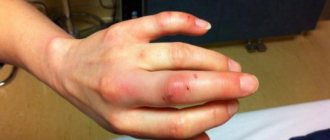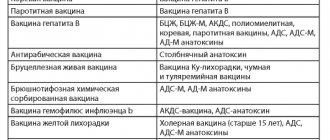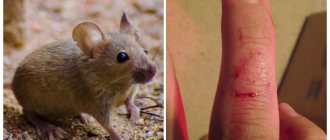Rabies in dogs is one of the most ancient diseases. The pathology is otherwise called “rabies” or “hydrophobia” because of its main symptom – panic fear of ordinary water.
The first mentions of manifestations of pathology in ferocious, indomitable dogs date back to the 5th century BC. e. About six centuries later, hydrophobia in humans was described. Even then it was established that people got sick after dog bites.
Epidemics of rabies have raged at various times in most countries of the world. To date, no cure has been synthesized. Only preventive measures are effective.
Signs of rabies after a dog bite in a person
Rabies is a dangerous infectious disease that disrupts the functioning of the central nervous system and leads to the death of animals and humans. Most often, the disease occurs after contact with the saliva of an infected domestic or stray dog. In this case, it is necessary to urgently seek medical help, since the disease is considered practically incurable after the first symptoms appear.
How can you get infected?
Dogs and other pets (cats, rodents, livestock) become infected with rabies after being bitten by an infected wild animal. Hunting and guard dogs are most at risk because they can leave the house and remain unattended by their owner. Therefore, it is very important to prevent any interactions between pets and stray animals. It is also necessary to carry out preventive vaccination of pets. Depending on the manufacturer, the vaccine provides protection against the disease for 1-3 years. If the pet is located in an epidemically unfavorable area, then revaccination must be completed every year.
Humans are infected with rabies by the penetration of saliva from an infected dog into the body through a wound or mucous surfaces. Most often this happens after a bite. The virus can enter the body after saliva gets on damaged skin (in the presence of scratches, abrasions, burns, etc.), face, hands. Therefore, after contact with an animal, it is necessary to treat the skin with antibacterial soap or antiseptic agents.
The rabies virus penetrates through the nerve pathways into the peripheral and central nervous systems, where it causes degenerative-dystrophic and necrotic processes. Cells of the spinal cord and brain cease to perform their functions and gradually die, which leads to significant disturbances in the functioning of the brain and subsequent death of a person.
Features of the disease and types of infection
The cause of rabies is the rabies virus, which penetrates the body of an animal or a person. The second definition of pathology is hydrophobia. The name is associated with the manifestation of a specific symptom - hydrophobia.
The development of the disease without emergency medical care inevitably leads to the death of the victim. The pathology manifests itself in infection with a brain virus, which results in damage to all systems of the human body. Death occurs from paralysis and destruction of vital organs.
People become infected with a dangerous virus as a consequence of a bite from a rabid dog, cat, or other animal. Infected saliva enters the victim’s body through damage to the skin, scratches, abrasions, burns, mucous membranes, most often as a result of a puncture or tissue rupture by the teeth of a sick animal. The likelihood of contracting rabies from a dog bite is high if the animal is not vaccinated, even if it is a pet. Those at risk of infection are primarily hunting and watchdogs that leave the area of the house and are unattended for some time by the owner.
Pets become infected with rabies from wild, street animals. Interaction between them should not be allowed to prevent infection. If a domestic cat gets sick after being bitten by a dog on the street, then it also becomes a potential carrier of a dangerous disease.
Symptoms of rabies after a dog bite
Signs of rabies after a dog bite in a person may take 10 or more days to appear. On average, the incubation period lasts from one to three months. In rare cases, the virus can develop asymptomatically in the body for one or several years. The appearance of symptoms of rabies in humans: indicates that the disease has progressed to a significant extent and serious pathological processes are already occurring in the central nervous system.
It is important to know! Treatment for rabies in humans is most effective BEFORE symptoms appear. Otherwise, the disease is almost impossible to cure, and it leads to death. Therefore, it is vital to seek medical attention immediately after receiving a bite from a suspected infected animal.
The disease has three stages of development, each of which is characterized by certain symptoms:
- The first stage is the prodromal (early) period. Duration 1-3 days. The first thing a person begins to worry about is the wound, even if it has healed long ago. There is pain in the wound, burning, itching. Redness and swelling may occur. There is an increase in body temperature to subfebrile levels (37.1-37.5 C), depression, anxiety, poor appetite, and insomnia.
- The second stage is the peak period. Duration 1-4 days. A person develops aggression, excessive agitation, and increased sensitivity to any irritants (bright lights, loud sounds, unpleasant odors, touches). Frequent cramps of various muscles are observed. Hydrophobia develops when a person experiences a spasm of the larynx when trying to drink some water. The spasm can block breathing, and later develops even when looking at water. Aerophobia, sound, visual and olfactory hallucinations appear. Salivation increases significantly.
- The third stage is the period of paralysis. Duration 1-2 days. Visually the patient becomes calmer. Paralysis of the limbs, eye muscles and facial muscles develops (sagging jaw). Death occurs as a result of paralysis of the heart muscle or respiratory organs.
On average, after the first symptoms appear, the disease lasts 5-10 days. The duration and rate of progression of the disease depend on the location of the bite, the extent of the wound, and the general health of the person. The most dangerous bites are considered to be on the head and face, as well as on the hands, where a large number of nerve fibers accumulate.
Symptoms of an infected animal
The carriers of the virus are often dogs, active explorers of their places of residence and surrounding areas. In areas close to forest areas, contacts between dogs and foxes, often suffering from rabies, are common. The symptoms of the disease cannot be noticed immediately; it goes unnoticed for some time. But you can see wounds, which should alert the dog owner. Observing your pet and contacting a veterinarian will clarify the situation.
It is more difficult when a street animal that attacks a person is infected. In appearance, signs of the disease are not always obvious. It is important to monitor how a rabid animal behaves after a bite and, if possible, isolate it for sanitary services and a veterinarian.
At the end of the incubation (hidden) period of the disease, symptoms in dogs are observed in the following manifestations:
- increased salivation;
- seizures;
- ignoring pain;
- refusal of water and food;
- increased aggression;
- development of strabismus;
- excessive affection;
- apathy, desire to hide.
There are quiet and violent varieties of the course of the disease, but they end in inevitable paralysis, paralysis, and death of the animal.
Rabies in dogs: symptoms
To suspect rabies in a dog, you need to pay attention to its behavior. The presence of certain symptoms may indicate danger to a person, which means you should not contact him. If we are talking about a stray animal, then it will be violent, aggressive, and avoid people. He has copious amounts of saliva and hoarse barking.
A pet dog becomes infected with rabies after contact with another animal. In this case, the owner may notice the presence of bites or abrasions on the pet. Over time, changes in behavior are observed, aggressiveness appears, and appetite worsens. One of the important signs of the disease is refusal of water. The dog experiences a spasm of the larynx, it cannot swallow, and saliva is produced heavily. If signs of disease appear, you should immediately contact a veterinarian.
I ran after and shouted: “Valera, run!”
The incident that led to the tragedy happened in August 2011 in the Iput-2 holiday village in the Gomel region. A few years earlier, Tatyana Ermakova, a Gomel resident, picked up and was giving birth to a puppy - a shepherd mongrel named Bruce. They settled her in the country, fenced off the enclosure, and issued an animal passport, which recorded the rabies vaccination given in June 2010. It expired in a year. According to the owner, she remembered this, but what prevented her from making a new one was that Bruce was constantly being bitten by ticks. In this case, vaccinations cannot be done. On August 22, Tatyana noticed that the dog’s pupils were greatly dilated. The woman visited four veterinary clinics, but, according to her, could not bring her pet to the appointment. The veterinarians refused to go to the “patient”. They recommended one thing: keep the dog on a chain and watch. If she has rabies, she will die in ten days... On August 26, Tatyana’s husband nevertheless brought a specialist who examined Bryusa, stroked her fur, asked about her diet, habits and said that she observed nothing clinically. About five o'clock on the same day, Tatyana drove up to the house and Bruce jumped out of the gate. As it turned out later, she managed to free herself from the collar. The dog looked excited and tried to squeeze into the car.
“I’ll be honest, I was scared,” recalls Tatyana Ermakova. “I myself was once severely bitten by a dog - I had to undergo a long treatment... After leaving the salon, she called the dog, but it ran away to the side. At that moment, the woman noticed a girl who was riding on the gate of her neighbor’s dacha. Six-year-old Valeria Zdrok from Minsk visited her grandparents in the summer. Tatyana claims that, having warned the child, she asked her to hide and she replied: “Okay.” After this, Bryusa finally approached her owner, who took her by the withers and began to lead her into the yard. “At that moment, Lera loudly hit the gate, and she jumped out into the street like a bullet,” says Tatyana. “I couldn’t even imagine how Bruce would react to the loud sound.” And she jumped back and rushed towards the girl... I ran after and shouted: “Valera, run!”, but she got scared and stood still, raising her arms... The dog knocked the child to the ground, dug his claws into the face, bit him in the forehead and ran on. . The first one near the girl was a neighbor who, seeing what was happening, ran out into the street. The child was carried into the house in their arms. Tatyana Ermakova says that she offered to provide first anti-rabies assistance, the purpose of which is precisely to prevent infection with the rabies virus. The woman learned how to do this while studying at the Agricultural Academy. However, the grandmother, whose emotional state can be understood, demanded to leave. Tatyana went after the dog, which was running around the village, not responding to the owner’s commands. It can be considered lucky that during this time Bruce did not attack anyone else... Realizing that she could not cope on her own, Ermakova called her hunter-in-law, who immediately arrived with a gun. He shot Bruce when she, having run up, returned to the familiar yard.
What to do if a person is bitten by a dog
Not every dog that bites a person carries the rabies virus. If a person is bitten by a domestic dog that is regularly vaccinated and has not previously had contact with stray animals, there is no need to be afraid, but you should still seek medical help. If a person is bitten by a stray dog, especially with symptoms of rabies, it is necessary to urgently go to the emergency room. The doctor will examine the wounds and prescribe appropriate treatment. The standard treatment and prevention of rabies in humans after a dog bite is the use of a vaccine.
The drug is administered six times according to the following schedule: day 0 (day of the first visit to the doctor), then days 3, 7, 14, 30, 90. Therapy will be most effective if treatment begins on the first day after injury, but no later than the 14th day. For adults, injections are given into the deltoid muscle, and for children - into the thigh. If it is possible to observe the behavior of the bitten animal and it does not show signs of the disease after 10 days, then further vaccination is canceled. After a course of vaccination, a person will develop immunity that will last for a year. If there is repeated contact with an infected animal after the end of this period, the course is repeated again.
If there are multiple deep bites, immunoglobulin may be used before vaccination. This is a drug containing ready-made antibodies, which is injected directly into the affected area. Immunoglobulin blocks the entry of the virus, however, it has stronger side effects than vaccination. Therefore, its use is determined by the attending physician individually.
Cases when you need to see a doctor right away
There are situations when it is necessary to consult a doctor after a person has been bitten by a cat. You need to remember well what to do in such cases. A person who has been bitten must urgently go to the nearest emergency room, present their compulsory medical insurance policy there and receive medical help.
If there is no need for emergency care, you should contact a surgeon at the clinic. The doctor will examine the wound and do all the necessary medical procedures.
You need to see a doctor if:
- the cat is foaming at the mouth and salivating heavily;
- the cat bit for no reason (this is how rabid animals attack);
- the wound is deep;
- bleeding does not stop;
- redness, pus, and swelling appeared;
- the temperature has increased;
- symptoms of anaphylactic shock occurred;
- bitten by a street cat;
- bitten by an unfamiliar cat.
In severe cases, you need to urgently contact a medical facility
Deep bite
Deep damage requires close medical supervision and thorough disinfection.
The deeper the bite, the greater the likelihood of pathogens entering it. Induration and swelling may appear on the skin. Such wounds will be very painful, inflamed and take a long time to heal. You need to cover them with a clean bandage, which should be changed daily until the wound heals.
Bitten by a street cat
Bites from stray cats are more dangerous than bites from domestic cats. A doctor is needed to conduct a thorough examination. It is not known what the stray cat is sick with. It is impossible to observe his condition and behavior. Therefore, it is necessary to go to the emergency room as soon as possible to disinfect the wound and administer a rabies vaccine and a tetanus shot.
For reference! If a person is bitten by a cat living on the street, then most likely the victim will be treated with antibiotics.
Most often, cats bite your hand or finger.
Bleeding
If bleeding does not stop for a long time or if an artery is damaged, then you need to go to the emergency room immediately.
The main sign of arterial damage is a pulsating stream of blood. Only a doctor can stop severe bleeding. He will bandage the wound and, if necessary, apply stitches. Cats can extremely rarely injure an artery, but safety precautions must not be forgotten.
Signs of rabies after a dog bite in a person
Signs of rabies after a dog bite in a person appear after a certain period of time, which can range from 10 days to a year. This depends on the state of the immune system, the location of the bite site and the amount of virus that entered the body at the time of infection. Unfortunately, the appearance of symptoms of the disease indicates the development of irreversible processes in the brain, and indicates that the person is doomed to a painful death.
The pathogen can only be resisted by administering an anti-rabies vaccine within the first 72 hours after its entry.
Knowing the behavior of animals with rabies can prevent exposure and reduce the risk of infection. But owners of pet dogs should undergo annual preventive vaccination, which will protect their pet from infection.
Degree of guilt
And the last is the judicial and legal aspect of history, the points of which have not been settled to this day. After Valeria’s death, her father contacted law enforcement agencies, demanding that the doctors at the children’s infectious diseases hospital be brought to justice, who, in the applicant’s opinion, did not provide medical care properly. The investigation was carried out alternately by the police department, the prosecutor's office and the department of the Investigative Committee of the Frunzensky district of Minsk. In February 2012, a decision was made to refuse to initiate criminal proceedings. And at the end of last year, Valeria’s father filed a civil suit for compensation for moral damages and funeral expenses. The total amount of the stated claims is almost 206 million rubles. The defendants are Tatyana Ermakova and her husband. The co-defendants are Ermakova’s daughter, since the dacha has belonged to her since 2009, and the Gomel Regional Clinical Hospital.
“I do not absolve myself of my part of the blame for this tragedy,” says Tatyana Ermakova. “As the owner of a source of increased danger, I am ready to bear responsibility and pay a reasonable amount of compensation. But at the same time, I am convinced that if the girl in Gomel had been given rabies immunoglobulin in a timely manner, she would not have died... The position of the regional hospital is reflected in the protocol of the court hearing: “... we believe that rabies infection and the subsequent death were not a consequence of the actions (inaction) of medical workers State Clinical Hospital, but as a result of a bite from a sick animal.” At the next meeting, which took place on March 1 of this year, the defendant filed a request to order a forensic medical examination, which was granted. In total, 20 questions were posed to the experts, 4 of them were “asked” by the State Clinical Clinical Hospital. Moreover, 3 of them relate to the assessment of the actions of their colleagues - workers of the Gomel Emergency Hospital.
Despite the fact that Ermakova’s petition was granted, she has strong doubts: “I don’t know what materials are being sent for examination and who will directly conduct it.” This is fundamentally important, since this expert commission should include a veterinarian, an infectious disease specialist, an epidemiologist, as well as specialists in providing anti-rabies care... Justifying the desire to obtain information regarding the examination, Tatyana Ermakova refers to Article 220 of the Civil Procedure Code of the Republic of Belarus. In accordance with it, “persons legally interested in the outcome of the case have the right to: demand the appointment of an examination; challenge experts; present questions to be posed to an expert; submit additional documents and other materials for expert research; get acquainted with the determination on the appointment of the examination and the expert’s conclusion; with the permission of the court, be present during the examination and provide explanations to the experts.” *** While preparing the material for publication, TUT.BY contacted the girl’s father for several days to get his comment. Evgeny Pavlovich did not refuse the conversation, but, unfortunately, he did not have time for it. However, we are ready to give him the floor at any time and present his vision of the situation of the injured party. Currently, until an expert opinion is received, a break has been announced at the court hearing. Upon completion of the process, we will inform readers about the results.
What is rabies in dogs
Despite the explanations often provided by the media, some people do not know what rabies in dogs is, how it manifests itself and what danger it poses to others.
This disease is viral in nature and is most often transmitted through bites during an attack by a sick animal, as well as when its saliva gets on damaged areas of the skin and mucous membranes.
Pets become infected through contact with wildlife, stray dogs and cats, rats, and bats. Uncontrolled presence of a pet in landfills, abandoned buildings, basements and other objects where potential carriers of the disease may live should not be allowed.
The first alarming sign is a change in behavioral reactions, manifested by uncharacteristic affection for a dog, aggressiveness, timidity, touchiness, isolation, and so on.
At the first stage of excitement, the animal often changes its lying position, catches non-existent insects, hides, and begins to swallow inedible objects. Sometimes vomiting appears, appetite sharply decreases, tactile sensitivity increases, and photophobia and hydrophobia begins.
After 1-3 days, the second stage begins, during which the following is observed:
- constant drooling;
- drooping jaw and prolapsed tongue;
- increase in temperature indicators;
- aggression;
- change in the nature of barking (it becomes hoarse and tearful);
- difficulty in swallowing;
- strabismus;
- convulsions.
During an attack, the dog goes berserk, chewing on objects around it and causing bodily harm to itself.
The third stage is characterized by:
- exhaustion;
- weakness;
- tonic convulsions;
- paralysis;
- decrease in body temperature below normal.
After 3-5 days the animal dies from cardiac and respiratory arrest.
Why is a bite from a sick dog dangerous?
In order to understand why a bite from a sick dog is dangerous, you need to know the mechanism of development of the disease.
The causative agent of rabies is a neurotropic virus that affects nerve fibers, but does not penetrate the bloodstream and lymph. Once in the tissues of the body, it begins to move along the ascending neurons of the cells, tending to the brain. At the same time, damage to the salivary glands occurs, which causes the presence of a large number of pathogenic microorganisms in saliva. Therefore, the rate of development of the disease directly depends on the point of penetration and the number of viruses entering the wound.
The greatest danger is caused by wounds to the head and neck, after which the probability of infection is 90%, and the first symptoms appear within 8-10 days. This figure drops to 60% when it comes to lesions of the trunk and hips, and 30% when it comes to the hands and feet.
Only timely and competent provision of first aid, as well as the administration of a vaccine, can save a person’s life.
What to do and how much time you have
It is very important to know what to do and how much time you have after a dog bite. To minimize the risk of infection, you must proceed according to the following scheme.
- Wash the wound with plenty of clean running water and treat with laundry soap.
- Wipe the intact skin around the wound with alcohol.
- Contact the nearest medical center for help.
Important! After being bitten by an animal that is a potential carrier of the rabies virus, it is prohibited to stop the bleeding, apply a bandage or suture the wound. A large number of pathogenic microorganisms are released along with the blood, and the risk of infection is reduced.
In a clinical setting, the doctor treats the wound with a specific immunoglobulin and prescribes rabies vaccine injections, injected into the shoulder area or under the shoulder blade on the day of injury, and then on days 5 and 40.
Important! Administration of the vaccine 72 hours after the bite is no longer able to prevent infection.
If possible, the dog is isolated and monitored. The absence of rabies symptoms indicates that the animal is healthy and the disease is not the cause of aggression. In this case, the last injection of the drug is not given.
How to recognize a sick dog
In many cases, knowledge of how to recognize a sick dog and avoid contact with it in time helps to avoid infection. At the stage of manifestation of such clinical signs as profuse salivation, the presence of foam on the lips and uncontrollable aggression, it is no longer possible to influence the animal with screams and warning movements. Therefore, the only way to prevent an attack is to hide in a protected place.
Once you are sure of your safety, you must inform the service for catching stray animals, a state veterinary clinic or a unit of the Ministry of Emergency Situations. Very clear signs of rabies are fear of light and fear of water. They develop as a result of painful spasms of the muscles of the pharynx and the lens of the eye, supported by mental phenomena caused by brain lesions.
But there are symptoms of rabies that cause more confusion than caution. Instead of aggression, the dog becomes affectionate and sociable for no reason. She can rub against your legs, jump on your lap, and lick your hands and face. Not knowing that these are signs of a fatal disease, people blithely allow her to do this. At this moment, the virus, released in saliva, enters the skin and mucous membranes, penetrates the tissue through microdamages and causes infection.
Incubation period for rabies in humans
From the entry of infection into the body until the appearance of the first clinical signs, a certain amount of time passes, called the incubation period of rabies in humans. Its duration ranges from 10 days to three months, depending on many factors.
- Localization of the bite. After a person receives severe injuries in the head, neck and shoulders, the time frame for the development of symptoms is 10-14 days. If the stomach, back and hips are affected, the period may increase to a month. Injury to the feet and palms can extend the latent period for six months or more.
- Age of the victim. In a child, the incubation period lasts less than in adults, and never lasts more than two weeks.
- Amount of damage. The deeper and more extensive the wound resulting from the bite, the greater the number of viruses that penetrate the body. This increases the rate at which clinical symptoms of rabies develop.
- The state of the human immune and nervous system. With strong immunity, the body’s defenses can restrain the spread of the pathogen for a certain time and prolong the latent phase of the disease. The susceptibility of nerve cells to the rabies virus also plays an important role.
Signs of an animal infection
A person can get the virus of a dangerous disease as a result of an attack by a sick cat or dog. They, in turn, become carriers of rabies, having received the virus from wild animals, strays, various rodents, and some species of birds. The disease is sometimes diagnosed even in pets who do not leave the walls of the apartment.
The cause of infection is close contact not only in the form of a bite, but also by licking a body that has scratches or wounds. Saliva with toxic contents penetrates through microdamages of the skin.
An animal infected with a virus does not immediately become aggressive; the incubation period of rabies in cats after a bite lasts from 4 days to several months, without manifesting itself in any way.
In later stages, manifestations are observed:
- refusal of food;
- hydrophobia;
- drooling, foaming at the mouth;
- aggressiveness;
- muscle cramps;
- loss of the instinct of self-preservation.
The paralytic stage with manifestations of spasms and convulsions lasts 2-4 days. The animal dies from disorders of the respiratory center and muscle paralysis.
Why do dogs bite?
Dog breeders claim that only a third of people injured by dog teeth did not have direct contact with the animal. In 60% of cases, a pet attacks a person during play or feeding, when he is teased or a bowl or toy is taken away. Bitches show aggression when protecting their puppies.
Often the provocateurs are children and teenagers who have not been trained to properly handle animals. Also dangerous are dogs of service and fighting breeds that have not completed a training course.
Why is a dog bite dangerous?
Damage caused by dog teeth ranges from mild to severe. In mild cases, the dog may apply slight pressure to the skin without even compromising its integrity. This is how the animal warns of its displeasure. Small dogs often have a vicious nature, but cannot cause serious damage. If a person is bitten by a fighting dog, then there is a high probability of lacerations, bleeding and even a broken bone.
Traumatic injuries that can occur after a dog bite:
- violation of skin integrity;
- muscle and tendon rupture;
- bone fractures;
- nerve damage;
- bleeding.
Another danger of animal bites is the infection of the wound by various bacteria and viruses contained in the dog's saliva. The microflora of the oral cavity of pets is quite aggressive. Pathogenic bacteria are introduced into the human body:
- streptococci;
- coli;
- staphylococci;
- pasteurella, etc.
The infection causes inflammation of the wound and enters the blood and lymph nodes . If anaerobic microorganisms multiply, there is a risk of developing gas gangrene.
It is possible for a wound to become infected even if it is bitten by a domestic dog until it bleeds. Bite wounds can cause rabies and tetanus.
Symptoms of wound infection after a dog bite
A bacterial infection can develop even if your own dog bites you. Signs of wound infection:
- severe swelling;
- redness;
- increased pain;
- enlargement of regional lymph nodes;
- increase in body temperature after a dog bite
- discharge of pus from the wound.
If not treated in a timely manner, the infection can spread beyond the lymph node and spread throughout the body. General blood infection – sepsis – develops.
Tetanus
Tetanus infection develops when the bacterium Clostridium tetanus enters the body. This microorganism can survive in the soil for a long time. The microbe enters the wound with soil, fur, and saliva of the animal.
Tetanus is a very dangerous infection. Even with modern treatment methods, mortality from it reaches 25% of the number of cases. In all civilized countries, mass vaccination against tetanus is carried out. In Russia, tetanus toxoid is included in the DTP (for children) and ADS (for adults) vaccines. These vaccinations are included in the national calendar and are given free of charge.
Rabies
The greatest danger from a dog bite is infection with rabies. This viral disease has a high mortality rate (almost 100%).
It is impossible to cure a person who exhibits symptoms of rabies..
The virus is transmitted when infected saliva enters the blood, skin or mucous membranes. Most often, a person becomes infected with rabies through the bite of wild animals (foxes, raccoons, badgers, squirrels, wolves). Stray dogs and cats are less likely to get rabies.
Signs of rabies in a dog
How does rabies manifest after a dog bite? The disease is characterized by a long incubation period - from several weeks to six months. The virus attacks the nervous system.
Symptoms of rabies in humans after a dog bite:
- pain or itching in the area of the healed wound;
- rise in temperature;
- hydrophobia, difficulty swallowing;
- muscle spasms;
- hallucinations;
- fear of light, loud sounds;
- mental disorder – aggression or, conversely, apathy.
Prevention of rabies
To prevent people from becoming infected with rabies, disease control measures have been developed at the state level. All farm animals are subject to mandatory preventive vaccination. There are programs to track rabies in wild animal populations and vaccinate them in disadvantaged areas. People are vaccinated against rabies if they are at risk.
By law, all dogs in Russia must be vaccinated against rabies. Vaccination is carried out free of charge at animal disease control stations
A person bitten by a dog that is not vaccinated against rabies receives a course of vaccine injections. The rabies virus develops slowly, so the vaccinated person has time to develop immunity to the disease. It is important to receive the first injection as early as possible: the likelihood of a successful outcome is high if the drug is administered within the first 72 hours.
There will be six injections in total: on days 1, 3, 7, 14, and 1 and 3 months after seeking help. If the attacking dog was kept under observation for 10 days and no signs of illness were found, then the last three injections are not given.
Features of vaccination
In addition to treating the wound and preventing inflammation, it is important to promptly protect the body from the spread of the virus, since rabies does not appear immediately after a dog bite. A drug is administered whose action is aimed at producing immunity in the body against rabies. Rabies vaccination can be planned or emergency; accordingly, vaccination schedules and preventive measures vary.
If the bite was received by an employee of a risk group in the profile of professional activity (an employee of a veterinary hospital, forestry, slaughterhouse), who had previously received the vaccine, then the injections are given on the day of treatment, on the third day after the bite, 7 days after the lesion.
Emergency assistance to a victim who has not previously been vaccinated against rabies consists of administering an anti-rabies vaccine:
- on the day of injury, the first hours after the bite;
- on the third day;
- 7 days after the bite;
- on the 14th day after the attack;
- 30 days after the first application;
- on day 90.
Injections in the form of a solution are placed in the deltoid muscle of the shoulder (for children - in the thigh), the patient is observed for 30 minutes, since an allergic reaction to the drug is possible.
There are restrictions for persons during the vaccination period:
- You should not drink alcohol until the end of the procedure and six months later - alcohol neutralizes the effect of the vaccine;
- Do not overcool, overheat, or be exposed to the sun - complications are possible;
- avoid increased physical activity.
If observations of the bitten dog and the information received do not confirm the signs of a rabid dog bite, then vaccination is stopped.
Cases of bites by sick animals with obvious signs of rabies (salivation, aggression, etc.) require enhanced protection of the victim - the introduction of homologous immunoglobulin containing antibodies that immediately act to suppress the virus. The drug has strong side effects, so the doctor decides on its use individually.
What to do if bitten by a dog?
What to do if an animal bites you? The victim is given first aid, then everything depends on the severity of the injury and the availability of vaccinations.
- If a dog bites a child, always consult a doctor.
- If the dog’s bite is not severe, it has a rabies vaccination, and the victim has a tetanus vaccination, you can limit yourself to self-medication.
- Contact a doctor if bitten by an unknown dog; if the wounds are on the face, neck or are torn; if the victim does not have a tetanus vaccination.
First aid for a dog bite is provided as follows.
- Wash the wound thoroughly with soap and water for 5-10 minutes. It is better to use regular laundry soap, as it has antiviral properties.
- Treat the wound surface with any antiseptic solution: 3% hydrogen peroxide, Chlorhexidine, Miramistin.
- The skin around the wound is lubricated with a 3% iodine solution or brilliant green.
- A bandage with antibacterial ointment (Levomekol, tetracycline, syntomycin) is applied to the wound. Dressing and treating the wound after a dog bite is done daily or every other day.
If the damage requires examination by a doctor, then apply a sterile bandage without ointments, lightly moistened with an antiseptic, to the wound.
- Hematomas without compromising the integrity of the skin can be lubricated with Indovazin, heparin ointment, and Troxerutin. This will reduce swelling and tenderness of the tissue.
For severe pain, take painkillers - paracetamol, Analgin, Ibuprofen. If there is heavy bleeding, water the wound with an antiseptic solution, apply a pressure bandage and go to the doctor.
Where to go for help?
In case of animal bites, seek medical help at the nearest emergency room. A trauma surgeon treats bites. For severe wounds or heavy bleeding, call an ambulance .
Perhaps, after visiting a doctor, you will need to solve the legal aspect of the problem: find the owner of the animal and bring him to justice or come to a peaceful agreement. At the hospital you need to take an extract, prescriptions for medications, receipts for paid services.
Was the death unpreventable?
In medical circles, the case of Valeria Zdrok’s death was examined for a long time and scrupulously. Five specialists, including a doctor of medical sciences, wrote the article “A case of rabies in a child: clinical manifestation, diagnostic difficulties, pathomorphological picture.” However, in addition to highly specific questions, one more, no less important, required an answer. Was everything done in the process of providing assistance and further treatment in order to save the girl’s life? The minutes of the clinical-anatomical conference note that at the stage of treatment at the Minsk Children's Infectious Diseases Hospital, medical care was provided in full. However, the death of the child was no longer preventable. Before this it is said: “Therapeutic and diagnostic measures at the stage of post-exposure treatment in Gomel were not carried out in full (anti-rabies immunoglobulin was not administered). At the outpatient stage in Minsk, it should be noted that pediatricians were not alert to the development of rabies, which, however, did not affect the outcome of the disease.” The last paragraph of the conclusion covers the problem more broadly: “At present, intravital diagnosis of rabies is not carried out in the Republic of Belarus. The complication of the epidemic situation requires the organization of express diagnostics, as well as the revision and correction of regulatory documents on the provision of medical care in cases of suspected rabies, in accordance with modern requirements.”
An analysis of the reasons was also carried out in Gomel, where, let us recall, there was no immunoglobulin in either of the two hospitals. How and why could this happen? The answers to this question were different. During the trial, which is discussed below, a representative of the State Clinical Clinical Hospital said that there was no immunoglobulin in other medical institutions in Gomel. As if this was clarified by the doctor on duty, who called medical institutions, “but it was Friday evening, he didn’t get through to anyone.” According to the same explanations, the doctor did not contact the pharmacy warehouse either. Firstly, according to the instructions, the doctor cannot get medicine there, and secondly, on Friday at 20.00 there is no one in the warehouse. At the same meeting, the mentioned health worker, in whose practice this was the first case of providing anti-rabies care, gave slightly different testimony. Having confirmed the absence of immunoglobulin, he noted that he could start looking for it by contacting other medical institutions, but “this would take a lot of time, which could not be allowed.” As a result of the proceedings, two doctors from the State Clinical Clinical Hospital were punished. They were reprimanded for underestimating the epidemiological situation and for not notifying the hospital administration about the lack of immunoglobulin. By the way, according to the documents presented by the State Clinical Hospital, on that very day - August 26, 2011, in the morning, a conference on the topic “Rabies” was held in the hospital, and the doctors took a test. But when a bitten girl was brought to the emergency room in the evening and it turned out that there was no immunoglobulin, they decided to simply do without it...
The only gratifying thing is that based on the results of the meeting of the treatment and control commission at the State Clinical Hospital, proper conclusions were made and a proposal was made: “Due to the shortage of rabies immunoglobulin, we ask the Regional Executive Committee to create a permanent (available around the clock) reserve of funds for immunoprophylaxis on the basis of one of the hospitals in Gomel and adequate treatment of rabies, as well as other infections, intoxications (tetanus serum and tetanus toxoid, rabies immunoglobulin and COCAB vaccine, anti-gangrenous serum, anti-snake serum, etc.).” One can only hope that the proposed measure did not remain only on paper.
Treatment for a dog bite
Treatment for dog bites is carried out on an outpatient basis.
- The wound is treated with antiseptic solutions.
- Surgical cleaning is carried out - dead tissue particles are removed.
- The bite wound is sutured only three days after the injury, since there is a risk of infection. Immediate stitches are applied for extensive lacerations, heavy bleeding, or for cosmetic purposes.
- After the bite heals, plastic surgery may be required.
- If necessary, a course of anti-rabies injections and a tetanus vaccine are prescribed.
- A course of antibiotics is prescribed to prevent the development of wound infection.
Further wound healing takes place under the supervision of a surgeon.
Consequences
A dog attack can have long-term consequences:
- psychological trauma;
- scar formation;
- the need for plastic surgery;
- dysfunction of muscles, tendons, joints;
- development of sepsis, gangrene, up to the loss of a limb.
To reduce the likelihood of complications, you should visit your doctor in a timely manner. You can treat a dog bite at home only for minor injuries or scratches caused by familiar animals that have been vaccinated against rabies.
How to protect yourself from a dog?
The following tips from dog handlers will help reduce the likelihood of an animal attack:
- do not provoke the manifestation of aggressive instincts: protection of food, offspring, territory;
- do not leave children alone with a dog, teach your child how to handle a pet correctly, do not allow contact with stray animals and unfamiliar dogs.
If an animal attacks, dog breeders advise doing the following:
- stop, turn to face the aggressor, if possible, press your back against a tree, fence, wall;
- do not swing your arms and legs;
- the best option is to hide in a building, a telephone booth, or in another place inaccessible to the dog;
- if a fight cannot be avoided, then they attack actively, using the most vulnerable points: the tip of the nose, bridge of the nose, groin, solar plexus, ribs, joints.
Stray animals attack humans only in extreme cases. Usually the matter is limited to barking and demonstration.
First aid
Meanwhile, Valeria's father and grandfather took her to the Gomel City Clinical Emergency Hospital (EMS). At the trauma center, primary surgical treatment of the wound was performed and the girl was sent for further treatment to the department of maxillofacial surgery of the regional clinical hospital (GOCH). Here the wounds were also treated and stitches were placed on the largest one left by the dog’s tooth. And at 20.20 they administered the rabies vaccine. At first glance, everything necessary was done. But there is a circumstance, the significance of which can only be assessed by delving into the specifics of providing anti-rabies assistance. Its main requirement is that in the event of a bite of the head, face, neck, hand, fingers, toes, genitals, or salivation of the mucous membranes by a wild or domestic animal, the victim immediately begins a course of injections. Rabies immunoglobulin and a rabies vaccine called COCAB are administered at the same time. The effectiveness of their combined use is higher, the less time has passed after the bite. However, neither the emergency hospital nor the city clinical hospital had anti-rabies immunoglobulin that day. More about this below, but for now let’s return to the chronology... On August 29 at 9.00, Valeria, who was in the hospital, was given the second dose of the vaccine. Doctors state the child’s satisfactory condition, the absence of complaints and inflammatory phenomena. Three hours later, a conclusion from the veterinary laboratory arrives by fax - the test for rabies of the dead Bryusa gave a positive result...
A consultation was held with a specialist from the regional Center for Hygiene and Epidemiology, who explained that in connection with the ongoing vaccination with rabies vaccine, the administration of rabies immunoglobulin is not indicated. On August 30 and 31, the child’s condition was considered satisfactory, and on the last day of summer the girl was discharged, with a recommendation to continue her treatment and visit specialists at the clinic at her place of residence.











